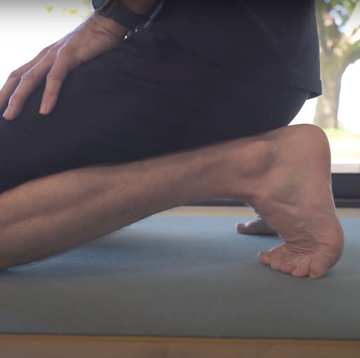Exactly what causes cramps is a surprisingly contested issue, but most sports scientists think of it as a neuromuscular issue, caused by a malfunction in a reflex between your muscle and spinal cord. One of the motor neurons becomes excited, and isn’t turned off, constantly stimulating the muscle to contract – in other words, cramp. What exactly causes this is what science is yet to determine, but an important factor is certainly local fatigue in the specific muscle.
Whatever the cause, here is the best way to treat, and hopefully prevent, those mid-run muscle cramps from felling you. Particularly those awful calf ones ...
How to dodge it
Preventing that localised fatigue from happening in the first place is the best way to lower your risk of developing cramp. How do you do that? The secret is a combination of sensible training and ‘appropriate execution' - or pacing to match your training level. For instance, if you’ve been training to run a marathon in four hours, don’t nail the first 10 miles on race day at 3:30 pace. It sounds very simple, but it can be one of the hardest things for runners to get right in distance racing: don’t try to ‘out-run’ your training.
For those who seem to suffer regular calf pains, there can be quite a few different reasons, but generally speaking they occur because the muscles in the posterior chain - including the glutes, hamstrings and calves - aren’t strong enough to handle the current workload. If pushed too hard, the muscle goes into a spasm, or those small painful contractions. Jordan Metzl, Foot-strengthening exercises for runners Amy Schlinger, NASM-CPT in New York explains that though it's less common, ‘cramps are [sometimes] due to nutritional issues such as hydration and electrolyte imbalances.’
What role does salt depletion play?
When people get cramps in marathons, the general received wisdom is that it's down to salt depletion. However, a new study actually suggests a different cause: a lack of strength training. Researchers signed up 84 marathoners who agreed to undergo a series of tests before and after their race. Of these, 24% complained of cramping in the race - but their sodium and potassium levels were no different from the non-crampers. However, their muscle biopsies were. The likely reason? Those who didn't get cramp were almost twice as likely to have included strength training in their build-up.
That’s not, of course, to say you shouldn’t pay attention to your hydration and sodium levels – you absolutely should, and there are other reasons why that will help your performance on race day. But contrary to what you might think, it’s not necessarily the chief cause of muscle cramps.
What to do if you get calf cramps?
While it’s tempting to just power through when you start to feel the pain, that’s not always a good idea. If the pain is only mild, it’s fine to try to shorten your stride and keep on running, explains Metzl. ‘If it feels more serious, I’d recommend pulling over and stretching it out,’ he says. Try stretches such as downward dog, a lunging calf stretch, or standing bent-over toe touches, depending on what you’re able to do without increasing the pain. Then you can try running on again.
Don’t obsess over stopping or losing valuable seconds – easing the cramp won’t just make those last miles more bearable, it will actually help to get you to the finish line quicker by enabling you to get back to a faster pace.
Exercises to strengthen calves
Given the important role that strength training seems to play in diminishing the likelihood of experiencing calf cramps, here are some calf-strengthening exercises worth trying:
1.Standing calf raise
Double-legged standing calf raises on a flat surface are your starting point. Do them first with the legs straight throughout and then with the knees bent throughout (so you’re ‘rolling’ forward as you lift the heels).
causes of hip pain and how to fix the problem.
2. Calf raise step
Progress to single-leg raises using a step: have your support leg’s foot on the next step up, with 30-40 per cent of your body weight on it, while you perform full-range raises with the other leg.
Amy Schlinger, NASM-CPT.
3. Single-leg calf raise
You’re ready for single-leg raises with your full weight on the working leg. Start with 3 set of 15, building to 25 each side. Add challenge with a barbell or weighted backpack (aim for half your weight).
Aim for 3 sets of 15 of straight leg/bent leg raises. Build to 25 each side.
Rick Pearson is the senior editor at Runner’s World UK. He’s been with the brand since 2017 and loves testing PB-friendly shoes for on and off road. Rick is a sub-three marathoner and occasionally likes to remind people of this on the Runner’s World podcast, which he co-hosts. He once raced a steam train over 14 miles (he won, narrowly) and a horse over a marathon (he lost, comfortably).

Amy Schlinger is a health and fitness writer and editor based in New York City whose work has appeared in Men’s Health, Women’s Health, The New York Post, Self, Shape, Cosmopolitan, Glamour, and more; The National Academy for Sports Medicine Certified Personal Trainer (NASM-CPT) is extremely passionate about healthy living and can often be found strength training at the gym when she isn’t interviewing trainers, doctors, medical professionals, nutritionists, or pro athletes for stories.
















